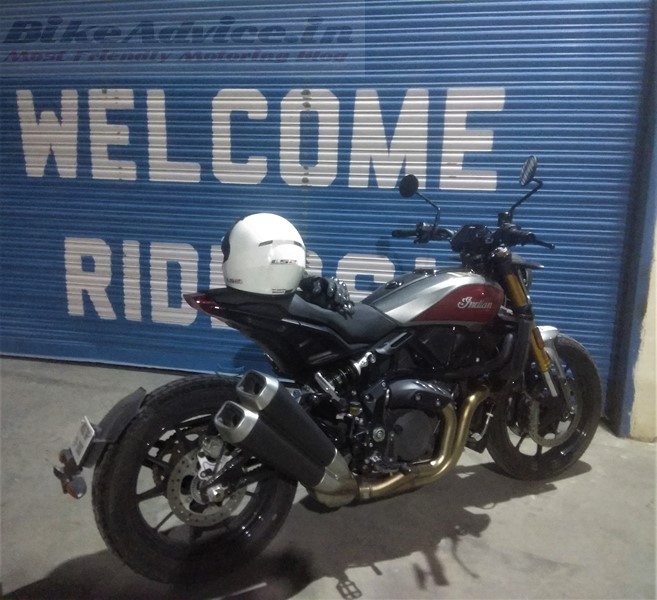Indian FTR 1200 Review By: Syed Shiraz
Before I start this Indian FTR 1200 review, please tell me what’s the first image that comes to your mind when you hear the words “American motorcycle”? A big cruiser would invariably form the core of that image, irrespective of the kind of fetishes you may be into. Burly men, tattoos, beer, empty highways, etc., might fill the rest of the frame. Of course, if you’ve read our Mumbai to Delhi travelogue you’d already be aware that American motorcycles can also run happily without tattoos, beer, Neanderthals, and perfect tarmac. The motorcycles were still big cruisers though. The best ones, I must add. In fact, all Indian motorcycles, be it the Scouts or the big Chiefs, are the best in their respective segments. And Indian has also been killing it on the flat tracks with their all-conquering FTR 750 race bike, which forms the basis of the motorcycle that you see in the pictures and videos below—the FTR 1200 S. The aforementioned image, of American motorcycles, is about to change. It really should, as the first V-twin motorcycle made by Indian in 1905 (they were making single cylinder motorcycles until then) was a race bike! The street V-twins came in two years later and none of them looked like cruisers.
Anyway, back to 2019 now. The FTR 1200 is here and it’s available in three variants: FTR 1200 (INR 14.99 lakh), FTR 1200 S (INR 15.99 lakh), and FTR 1200 S RR (INR 17.99 lakh), all prices are ex-showroom Delhi. The Indian website correctly lists only the former two as variants because the third is essentially an S model with Akrapovic exhausts and the race bike’s paint scheme. I mentioned three variants as these are indeed the three FTR motorcycles you can buy right off the showroom floor.
Well, the base model might not be on display in showrooms, but Indian will get it on order for you. And then they are offering a whole lot of accessories to suit four distinct riding styles: Rally, Tracker, Sport, and Tour. The media units given to all journos were the stock FTR 1200 S models. I must also add here that most other manufacturers can learn how to conduct first media rides from Indian Motorcycles.
So rather than cramming hordes of journalists into a single day of riding (where each reviewer just gets 20-30 mins of saddle time), Indian spread it out to over more than ten days, where two media units were allocated at different points in the city. You could choose one as per your convenience, reach there in the morning, and ride the bike to your heart’s content. Brilliant! Thank you, Indian Motorcycles. The format allowed everyone to test the bike thoroughly, save for the fuel efficiency, but I’ll still give you an idea about it. But let’s start with the design first.
Indian FTR 1200 Review: Design, Instrumentation, and Build Quality
Indian calls it a “flat tracker for the street”, and they could have used the definite article (“the”, instead of “a”, for the uninitiated) here as this is the only flat tracker you can buy, not in just in India but anywhere in the world. But what is a flat tracker? In short, it’s a motorcycle designed to go fast around a flat dirt-track. It looks like the bike you see here in pictures, sans fenders, headlight, taillight, blinkers, registration plate, and the front brake, among a few other bits. Look up Indian FTR 750 and H-D XR 750—two of the most authentic flat track racers.
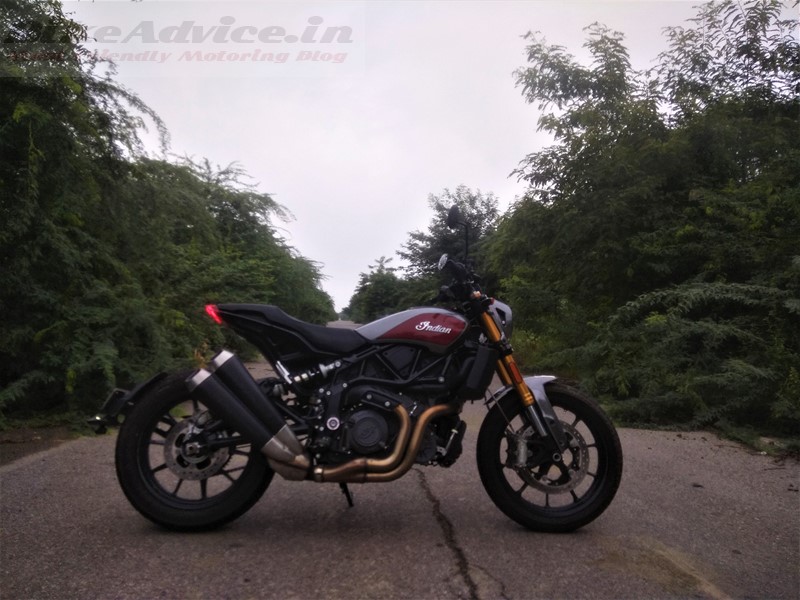
You might notice that a flat tracker is a motorcycle whose form is more raw than even a scrambler’s, bobber’s, or cafe racer’s. The FTR 1200’s design stays true to the flat track theme but without making it look unfinished or compromised for a production bike! Also, keeping in mind our traffic conditions, you can get rid of that heavy frame at the rear which carries the registration plate, blinkers, and the miniature tyre hugger, with a little help from the Indian accessories section, and move it up on the tail where they rightfully belong.
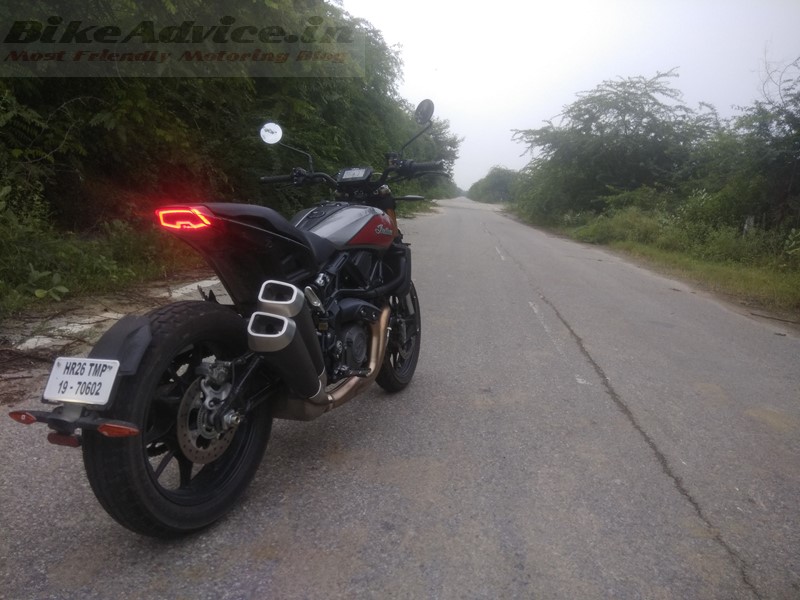
I won’t get it into describing individual parts such how the trellis frame is more exposed than the arms of a new gym-goer or how the fuel tank merges more easily into the seat than politicians of opposite parties into each other behind the curtains. You have eyes, you can see. I won’t give you a pair of rose-tinted glasses. But I will certainly tell you stuff you can’t determine from pictures and spec sheets. Size would be the first thing. The FTR looks bigger in flesh and metal than in might appear in pictures, but not intimidatingly so.
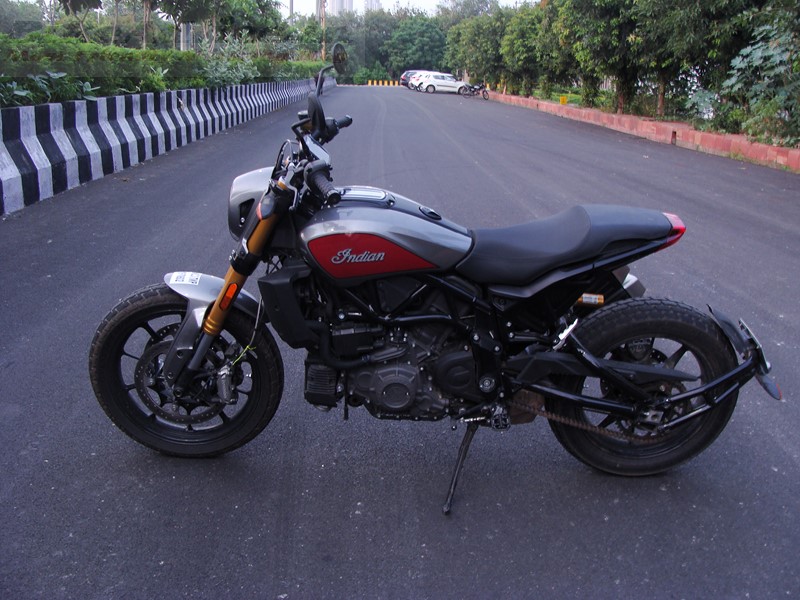
And it also does turn a lot of heads wherever it goes! In the past few years, and in almost all parts of the country, people have seen all types of “superbikes” (‘big bikes with fairing’ in common parlance), cruisers, and nakeds, so nowadays big bikes do not grab that many eyeballs as they used to earlier. But this one did, and I think it will always do just like the other peculiar designs such as the Diavel and XDiavel. Those two motorcycles still attract a lot of attention too.
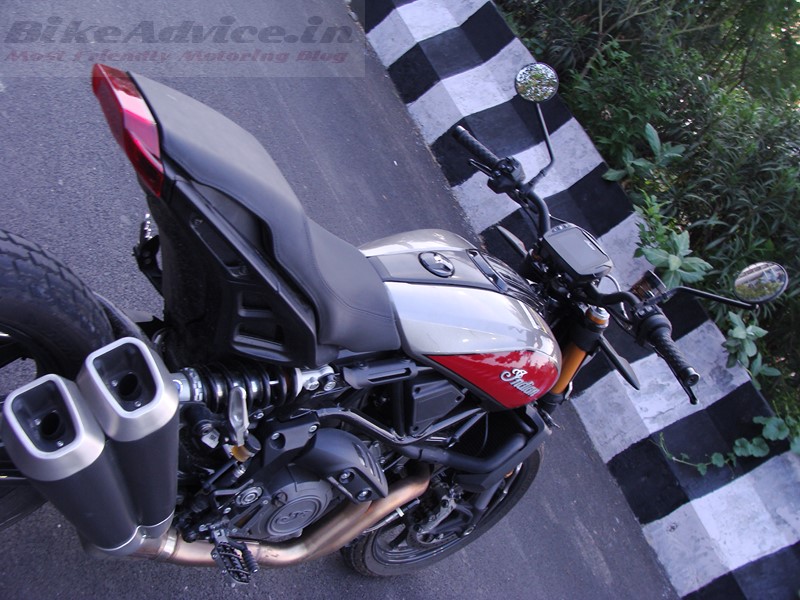
I will also tell you about the lovely 4.3-inch coloured touchscreen (Indian calls it “Ride Command Touchscreen”) on the FTR. The base model FTR 1200 (without the S suffix) doesn’t get it. That one houses a traditional single pod, non-adjustable suspension, and comes in an all-black shade, no other colour options there. It also doesn’t get the three ride modes (Rain, Standard, and Sport) and though I haven’t confirmed with Indian, my guess is the base model’s ECU map should be the one that’s called Standard in our bike. The base model does get cruise control, ABS, and traction control though. The best part about the FTR’s touchscreen is that you can operate it while wearing gloves.

You can also swipe up and down to choose any of the two display patterns; you can toggle through the various tabs of information using the switches on the handlebar, or use the dedicated buttons on the panel itself! I, a rider from the pure analogue era, loved using the touchscreen, and didn’t find the need to use the panel buttons at all. Millennials will love it even more. The handlebar switches definitely prove to be handy while on the move, of course. Oh, there’s Bluetooth connectivity for your phone and music, and a USB port too in the touchscreen panel.
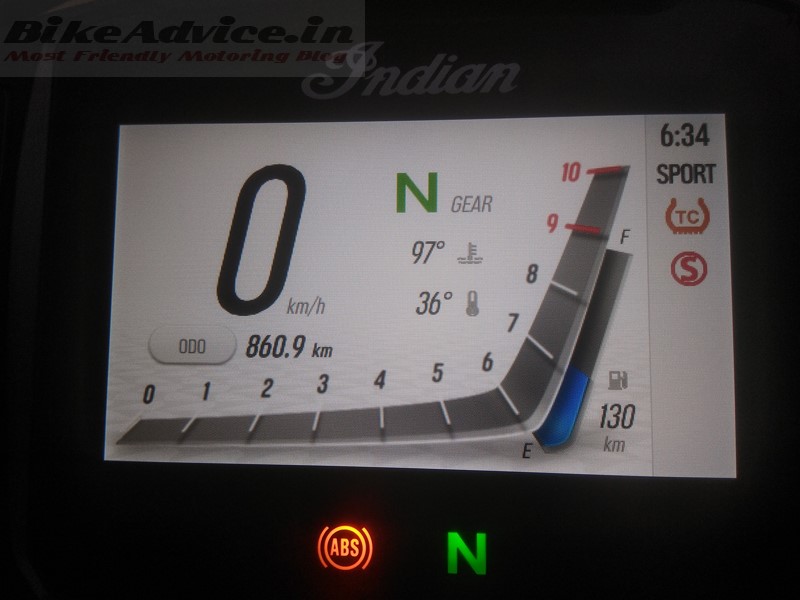
The build quality as expected is exemplary. However, there are three things that I would like to mention here. I am nitpicking, but I have to. The rear view mirrors look too basic for this bike, although they do their job just fine despite appearing quite small for it.

Secondly, the clutch lever isn’t adjustable for span. It should have been. These two aren’t quality issues, but I had to mention because trivial cost cutting isn’t something I would expect from Indian.

The third thing is the cm or two long exposed wires coming out of the left hand side switchbox on the handlebar.

It’s minuscule and most might not even notice, but it’s there. Everything else on the bike feels that it would survive a nuclear war too.
Indian FTR 1200 Review: Ergonomics
This is a TALL motorcycle, fellas! The saddle height is 853 mm, which makes it the perfect bike for people who are around six feet tall and above. Those between 5’6″ and 5’9″ should be able to place the balls of their feet on both sides, depending on their inseams, whereas those below that range will need thick-soled boots and a prayer before straddling the FTR. The good news is that it is quite narrow around its ‘waist’, which facilitates a straighter reach for your legs. The slimness also makes you “feel” that it’s a light and compact motorcycle, which certainly helps riding—what is actually a large motorcycle—in traffic. You sit ON the FTR as opposed to sitting IN most other bikes. The reach to the wide handlebar wasn’t inconvenient for a short rider like me, so I reckon that taller folks will be even more comfortable. The footpegs have just a hint of rear bias about them, and the resultant position reminds you of the bike’s sporty character but without getting uncomfortable.

Talking about comfort, the saddle itself is quite comfortable, and I think it will hold good while touring as well. But you will need a windshield (Indian has one in their accessories section) if you plan to go touring on this one, as the windblast is the most severe that I have experienced till date on any motorcycle. I know I have said that people who talk about windblast on a naked motorcycle are wimps, and I still maintain that, but the aforementioned ‘sitting-on-top’ riding position on this one exposes your entire torso to the wind Gods and their allies. Or it might be due to the insane pull of the FTR 1200’s engine!
Indian FTR 1200 Review: Performance
It’s relentless! I would never recommend this motorcycle to a newbie unless he has a deathwish or something. Even expert riders would need to be careful with this one! Don’t look at the relatively humble 123 hp figure. In fact, you shouldn’t be looking at horsepower figures while buying any of the big bikes, unless you live to test top speeds only. Torque is what you should be looking at, and the FTR produces oodles of it—120 Nm, that too at just 6,000 rpm! For perspective, the firebreathing Ninja ZX-10R produces 114.9 Nm at 11,200 rpm. I recommend you take a minute or two to let that sink in.

The FTR’s pull, I repeat, is insane! Initially, I thought that it’s the fuelling that’s abrupt, but it isn’t. The fuelling is near perfect; it’s just that there’s a threatening amount of shove present almost everywhere in the rev range. I say threatening because every time you give it some throttle, the intensity of forward thrust is greater than you had anticipated, which catches you by surprise. For example, while riding sanely, say, at 60 km/h, you want to overtake the two lidless lovebirds on that RE ahead you, so you give some throttle to allow them more privacy. That should be a normal, non-whiplash inducing maneuver, right? No, not when you’re on the FTR. On this Indian, you shoot ahead with such ferocity that it’s not only overwhelming for you, but also for the lost-in-themselves couple whose dead civic sense gets awakened and they start behaving themselves on the road.

But that’s not to say that the FTR can’t be ridden slow. In fact, you can take it down to 48 km/h in 6th gear (around 1,800 rpm) and it will pull cleanly from there too without protesting one bit! But if you want to ride like that, there’s a ride mode for it. It’s called the Rain mode, and it’s what you should be riding in when you don’t want your elbow and shoulder sockets to be elongated. And contrary to what a few reviewers might tell you, you do not have to wait for the actual rain to ride in the Rain mode. The throttle response is mellowed, but it never gets lazy, so do not take it for granted! In Standard mode, the throttle response is instant, whereas in Sport mode the power is delivered to you a day in advance. And then you have a Track mode, which is nothing but Sport mode with ABS and Traction Control switched off. Suicide mode, in other words.

I repeat: this bike is not for rich novices. It has cornering ABS and traction control, wheelie control, libido control, but no amount of electronics can save you if you’re stupid. Not until they develop a highly advanced auto-braking system for motorcycles that works at all speeds.
Talking about torque, power, and speed, I think this is the right moment for me to share the short video clips of the FTR’s acceleration, top speed, and in-gear acceleration too. Here they are, then:
You might have noticed that the bike has superbike-rivalling acceleration whereas the in-gear acceleration will leave almost all liter-class missiles for dead. A friend who just bought a Busa and also has a GSA 1250 in the family isn’t pleased with the FTR’s restricted top speed though. He has really liked the FTR but feels that Indian should have at least pushed the limiter from the current 199 km/h to 220 km/h. I did tell him that the majority of FTR buyers won’t care about the top speed; they would be happy using Indian’s fantastic cruise control at maybe 110-120 km/h while touring, and content in the knowledge that they can overtake everything at those speeds quicker than almost everything but a few on the planet.

However, I am compelled to agree with him upon realizing that when both the Scouts do 200 km/h easily, the more powerful FTR should have been left to do a bit more. That said, I am sure a few mad owners will remove the limiter and see the bike hitting a top speed somewhere around 230-240 km/h. Also, Indian should have provided a quickshifter at this price, but, honestly, you don’t NEED one on this bike. The six-speed gearbox shifts positively and you won’t find a false neutral unless you’re a noob. The bike responds well to clutchless upshifts too. No issues, whatsoever.
Indian FTR 1200 Review: Ride & Handling
But it’s not about that or the top speed with the FTR. It’s about being able to go anywhere you like, irrespective of the surface, season, or reason. I mean, a motorcycle should ideally be able to take you anywhere you want: to the track, to the mall, to hills, to office, to places you haven’t seen yet, basically everywhere. The FTR will.
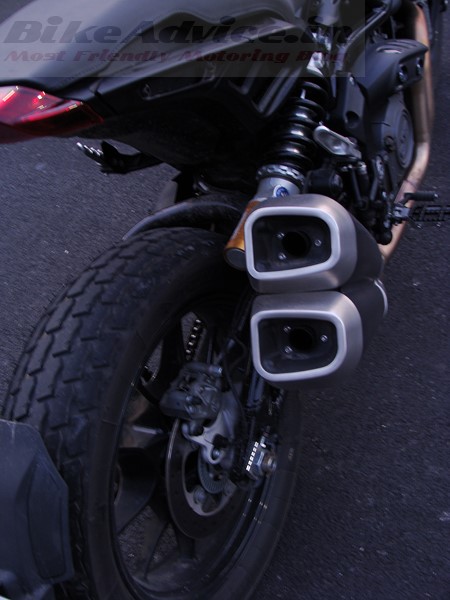
Because, first of all, despite weighing a heavy 231 kg with a full tank of fuel (the Diavel 1260 weighs 244 kg with a full tank), it doesn’t feel as heavy while pushing/pulling it manually (with the engine switched off) in and out of tight spaces. It’s all thanks to better mass centralization and low center of gravity. Indian could achieve that by changing the placement of a few crucial components. The battery is placed ahead of the engine, behind the front tyre; the airbox occupies the first half (right behind the headstock) of what appears to be the fuel tank but isn’t, whereas the rest of it is claimed by the fuel filler cap and its neck leading to the rest of the actual fuel tank under the seat. Don’t worry, you’d still fill fuel conventionally; it’s just that the filler cap now sits closer to your family jewels so you’ll have to be a bit more careful.
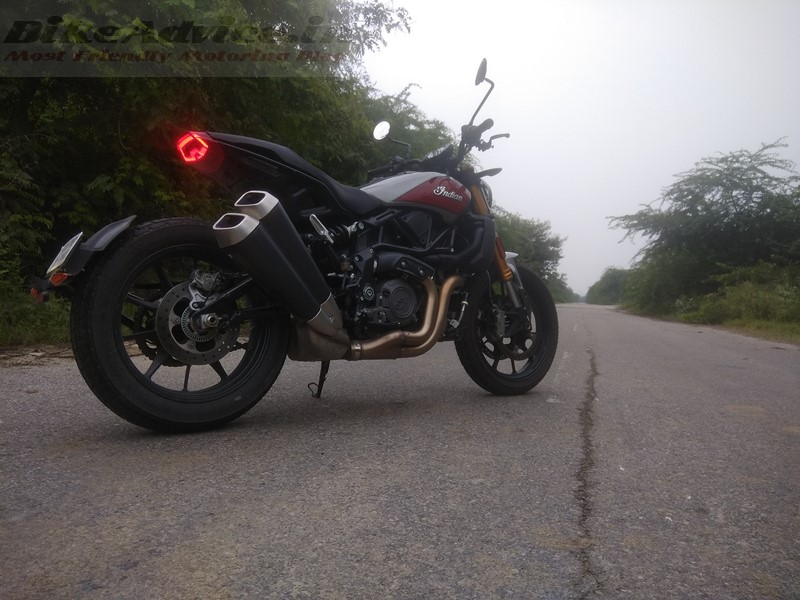
And thanks again to the aforesaid mass centralization and low center of gravity, the FTR feels much lighter on the move too, obviously. As a result you do not feel intimidated upon the first sight of thick, crawling traffic. Side to side flicks are effortless, further emphasizing how beautifully balanced this bike is really. The steering isn’t heavy at all too, which I didn’t expect at first considering that 19-inch front wheel has a lot of rubber slapped around it. I also didn’t expect good tyre grip from those flat track inspired tyres, but they held surprisingly well, both on tarmac and whatever dirt I could find, which wasn’t much to be honest. But it could still assure me that it would do justice to its flat track design in dirt as long as you do not consider it an MX bike.
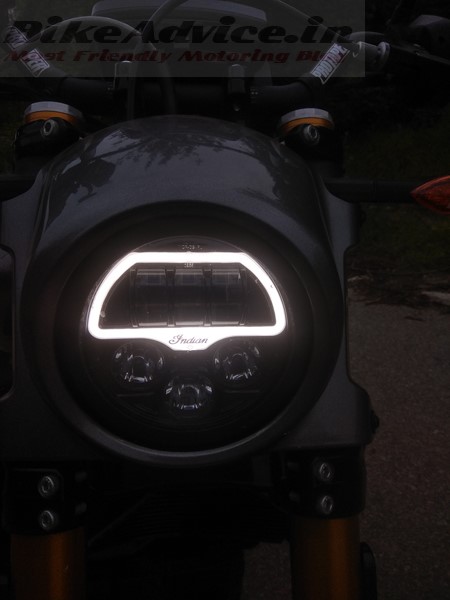
This S model has fully adjustable suspension at both ends with lots of travel. The stock suspension setting was certainly on the stiffer side for my featherweight self, but I am sure riders weighing more than a quintal too would be able to fine tune the suspension to achieve the desired ride quality. Also, the 183 mm ground clearance clears your mind of any worries about scraping the FTR’s underside over the most brazenly constructed illegal speedbreakers.
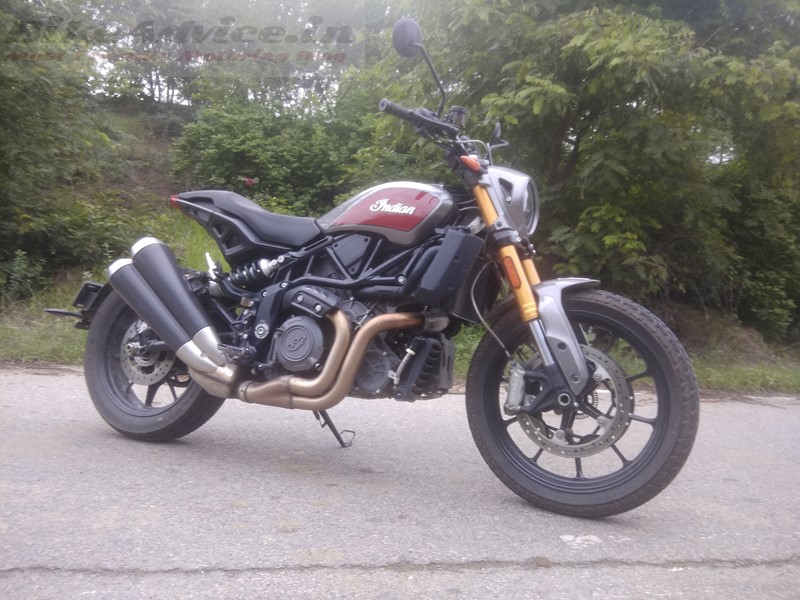
The wonderful brakes anyway ensure that you come to a quick and safe halt upon sighting such anomalies even at the last moment. And then there’s the headlight of this motorcycle. It’s not a headlight; it’s God’s Light. It doesn’t merely light up your path; it enlightens everyone in it, and bestows upon them the wisdom to get the, er, hell out of your way. Here, see for yourself:
Indian FTR 1200 Review: Fuel Efficiency
The FTR 1200’s engine is more or less the Scout’s motor, albeit with a few more ccs and a lot more power and torque. You might not have noticed, but the FTR race bike was known as the “Scout FTR 750” upon its debut. Even the fuel tank capacity of both the road bikes is similar: 13 liters on the FTR and 12.5 liters on the Scout. But, the FTR is lighter. But, it would be ridden harder!

While touring, the Scout gives you a tank range of a shade over 300 km with the low fuel light coming on anywhere between 250 and 275 km. Although the FTR has a distance-to-empty indicator, which is one feature I feel should be in every vehicle, I reckon that while touring it would run for about 200 km before the low fuel light comes on. In city, expect it glow anywhere after 150-160 km. For the record, I rode the bike for 137 km (which includes the repeated speed runs); the low fuel light didn’t come on and the range was still showing 59 km.
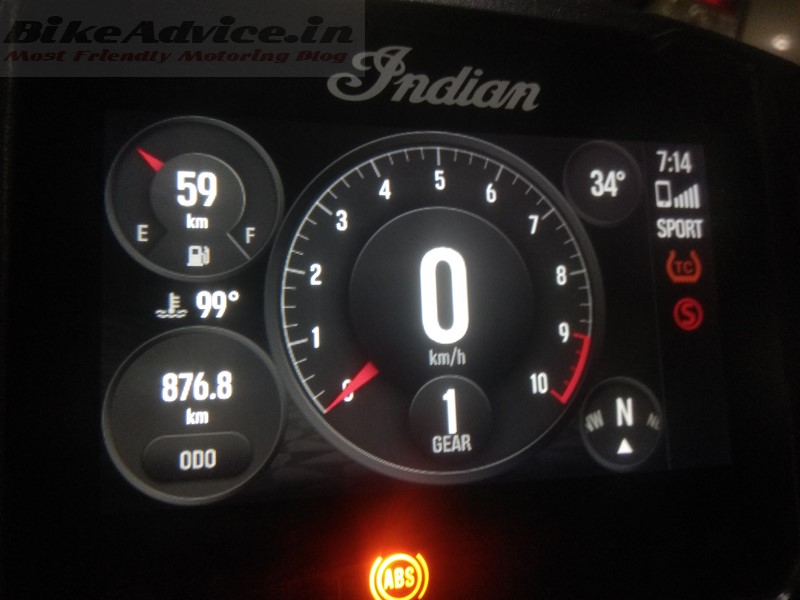
Indian FTR 1200 Review: Verdict
So who would buy this motorcycle? See, this bike has only one flaw: its price. And though that’s true for most big motorcycles in India right now, there are a few that still appear tremendous value for money, the Hayabusa, ZX-10R, and Speed Triple, for example. And these three are terrific motorcycles too. But the FTR’s buyer isn’t in the market for such motorcycles.

He doesn’t want a faired “superbike” because he thinks they aren’t practical for our conditions. He doesn’t want a naked because he thinks that they’re too common. He also doesn’t want a heavy cruiser that’s almost redundant for city rides. An adventure bike won’t cut it as well because he thinks he would look funny commuting to work on it. He also thinks that the ADVs are unnecessarily big and heavy for city riding and as good (read: “as bad”) as a heavy 2WD SUV in real off-road conditions.

Therefore, he wants something that he should be able to ride to work everyday; not that he would, but he doesn’t want to rule out the possibility. He wants to tour on it, so it should be able to handle bad roads and dirt trails with aplomb. He doesn’t want a Ducati Scrambler because though it’s all the motorcycle you need in India, he feels that it doesn’t have the cool quotient in abundance. Essentially, he wants a bike that can do it all, but one that still looks the coolest doing it all! He wants the best, and doesn’t mind shelling out the cash for it. The Indian FTR 1200 S is one such motorcycle for him.
